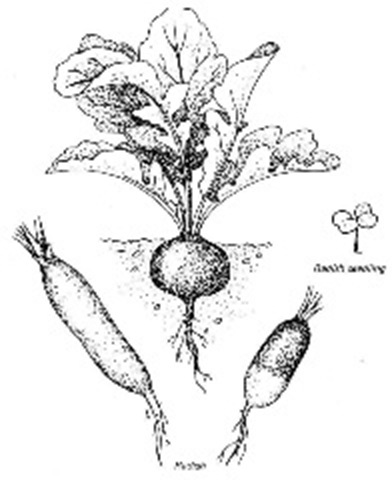Common name: radish Botanical name: Raphanus
sativus (spring radish),
Raphanus sativus
longipinnatus (winter radish) Origin: temperate Asia
Varieties
Radishes can be grown for a spring or winter crop. Spring varieties are the commonly known small red varieties. Winter radishes are larger and more oval and can grow eight or nine
inches long. The following are a few of the varieties available. Spring crop: Cherry Belle (22 days); Burpee White (25 days). Winter crop: Black Spanish (55 days); White Chinese (60 days).
Description
Radishes are hardy annuals or biennials that produce white, red, or black roots and stems under a rosette of lobed leaves. They’re fun to grow, and youngsters get hooked on gardening after growing radishes more than any other vegetable. A bunch of radishes, well washed, makes a great posy to give away. Radishes are distant relations to horseradish.
Where and when to grow
Radishes are cool-season crops and can take temperatures below freezing. You can grow them anywhere in the United States, and they mature in such a short time that you can get two to three crops in spring alone. Start planting them from seed in the garden two or three weeks before the average date of last frost for your area. Radishes germinate quickly and are often used with slower-growing seeds to mark the rows. Spring radishes produce a crop so fast that in the excitement very few people ask about the quality of the crop. Radishes can also be grown in six-inch pots in a bright, cool window. They will grow in sand if watered with liquid, all-purpose fertilizer diluted to quarter strength.
How to plant
Radishes tolerate partial shade and like well-worked, well-drained soil. When you’re preparing the soil for planting, work in a complete, well-balanced fertilizer at the rate of one pound per 100 square feet or 10 pounds per 1,000 square feet. If you’re planting winter radishes, be sure to loosen the soil well and remove soil lumps or rocks that might cause the roots to become deformed. Plant seeds half an inch deep in rows or wide rows 12 to 18 inches apart. When the seedlings are large enough to handle, thin them according to the variety; thin small spring varieties one to three inches apart, and give winter varieties a little more space.
Fertilizing and watering
Fertilize before planting and again at midseason, at the same rate as the rest of the garden. Detailed information on fertilizing is given in “Spadework: The Essential Soil” in Parti.Give radishes enough water to keep the roots growing quickly.


Overcrowding can ruin your root vegetable crops; thin radishes so that the roots have room to develop.
If the water supply is low, radishes become woody.
Special handling
Radishes sometimes bolt, or go to seed, in the summer, but this is more often a question of day length than of temperature. Cover the plants in midsummer so they only get an eight-hour day; a 12-hour day produces flowers and seeds but no radishes.
Pests
Aphids and root maggots occasionally attack radishes, but you harvest radishes so quickly that pests are not a serious problem. You can pinch out aphid-infested foliage, and drench the soil around the plants with Diazinon to control root maggots. Detailed information on pest control is given in “Keeping Your Garden Healthy” in Part 1.
Diseases
Radishes have no serious disease problems.
When and how to harvest
Time from planting to harvest is 20 to 30 days for spring radishes, 50 to 60 days for winter radishes. Pull up the whole plant when the radishes are the right size. Test-pull a few or push the soil aside gently to judge the size, and remember that the biggest radishes aren’t necessarily the best. If you wait too long to harvest, the centers of spring radishes become pithy.
Storing and preserving
Radishes will store for one to two weeks in the refrigerator. You can also sprout radish seeds. Detailed information on storing and preserving is given in Part 3.
Serving suggestions
Radishes can be sculptured into rosettes or just sliced into a salad. They are low in calories and make good cookie substitutes when you have to nibble. Put radishes on a relish tray, or on a platter of vegetables for dipping. Try “pickling” the excess crop by mincing them and marinating in vinegar.
